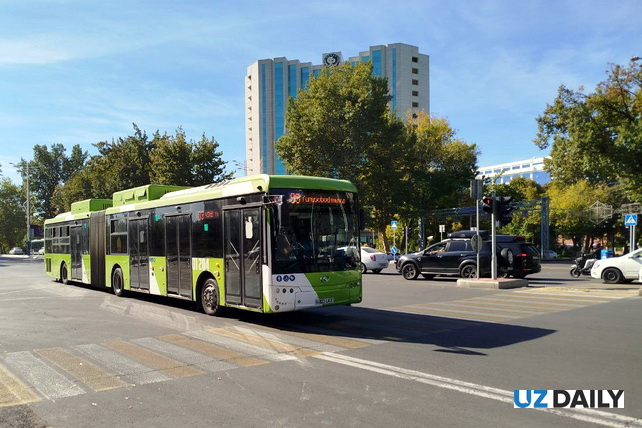
The “Yuksalish” Survey Reveals Systemic Problems in Uzbekistan’s Road Infrastructure and Pedestrian Safety
The “Yuksalish” Survey Reveals Systemic Problems in Uzbekistan’s Road Infrastructure and Pedestrian Safety
Tashkent, Uzbekistan (UzDaily.com) — The public movement “Yuksalish” conducted a comprehensive sociological survey addressing issues of road safety for both vehicles and pedestrians, as well as the condition of highways and residential streets along with their related infrastructure.
The study involved 2,743 respondents, of whom 46.36% live in rural areas, while 44.94% reside in urban districts.
Assessments of regional highways revealed significant problems. Only 10.38% of respondents described the roads as “excellent,” 35.55% rated them as “good,” 27.95% as “satisfactory,” 18.01% as “unsatisfactory,” and 7.71% deemed them “very poor.” This distribution of opinions reflects a prevailing negative perception of the road infrastructure and doubts about the quality of repair work.
Evaluations of residential streets proved even more critical. Only 9.28% characterized these roads as “excellent,” while 33.1% rated them “good.” Meanwhile, 27.62% considered them “satisfactory,” 19.69% “unsatisfactory,” and 9.68% “very poor.” These findings indicate that the condition of local roads is a major source of concern among the population.
Nearly half of respondents — 47.23% — reported that road repairs had been carried out in their neighborhoods in recent years. The main types of work included laying new asphalt (28.72%) and resurfacing existing pavement (13.96%). However, 26.17% of respondents indicated that no roadwork had taken place in their localities.
Pedestrian safety remains a pressing issue. Almost 40% of those surveyed believe that the roads in their communities are unsafe for pedestrians, while another 39% assessed the situation as “average,” and only 21% considered it “safe.” Only 41% feel that pedestrian crossings are equipped with adequate safety measures; 31% disagree, and 27% find the measures insufficient. These figures reveal significant gaps in pedestrian infrastructure and safety.
Only 44.61% of respondents reported the presence of sidewalks near their homes, 28.75% stated that sidewalks were completely absent, and 25.47% regarded existing sidewalks as only partially or poorly maintained. The accessibility of sidewalks for people with disabilities is especially alarming. Only 20.64% consider sidewalks convenient, while 39.82% describe them as “partially convenient,” and 38.98% as “inconvenient.”
Among the most frequently suggested improvements are widening roadways, performing high-quality major repairs, and modernizing the entire road infrastructure system.
The results clearly reflect citizens’ concern over the state of highways and residential roads, as well as the level of protection for pedestrians, especially those with limited mobility. All this points to systemic issues that pose a threat not only to the efficiency of transportation but also to the lives and health of citizens, including children.
Particular alarm is raised by the increase in serious road traffic accidents. This underscores the urgent need to adopt modern approaches to road safety and to carry out deep, comprehensive reforms.
Based on these findings, the “Yuksalish” movement, in collaboration with relevant experts, developed a series of recommendations:
It is necessary to approve a state program to install required traffic signs while removing redundant and outdated ones. Continuous monitoring of road markings’ quality and their compliance with established standards should be ensured.
All technical regulations related to traffic organization — from markings and signs to road surface quality (including issues like rutting) — require revision to align with modern international standards.
Mandatory full adaptation of all new and upgraded road infrastructure objects to meet the needs of people with disabilities and limited mobility must be introduced. Each road segment should have an assigned responsible person or organization accountable for its condition.
Fines should be determined based on the public danger posed by violations and the population’s ability to pay. Revenue from fines must be allocated exclusively to improving road infrastructure and enhancing safety, with full transparency in their use.
It is recommended to introduce mandatory independent audits of all road projects prior to their implementation and to remove operational and enforcement services for signs and markings from the Ministry of Internal Affairs’ jurisdiction, transforming them into independent bodies.
Current urban planning regulations should be revised to require safe, well-lit, and continuous pedestrian and bicycle paths accessible to people with disabilities, with stricter control over compliance.
Special attention should be given to implementing electronic traffic signs capable of dynamically adjusting speed limits based on time of day and weather conditions — especially near schools and in high-accident zones.
An open rating system should be created to evaluate road conditions, accident statistics, and citizen complaints in every district and city, with regular public updates.
Interactive maps of safe routes for schoolchildren from home to school should be developed, with mandatory lighting and equipped pedestrian crossings.
A national program should be launched to cultivate a culture of road behavior, respect for pedestrians, and mutual assistance on the roads. This would include disseminating social videos, educational courses, and awareness campaigns.
An urgent task is to establish an operational response system for reports of malfunctioning traffic lights, damaged signs, and other violations, ensuring issues are resolved within 24 hours.
Finally, it is essential to mandate public-expert review of all road projects involving independent specialists, representatives of vulnerable groups, and active citizens — with projects approved only upon positive evaluation.
Ensuring road safety is an integral part of national policy and a crucial element of a modern urban environment. The effectiveness of measures in this area directly affects the preservation of citizens’ lives and health.